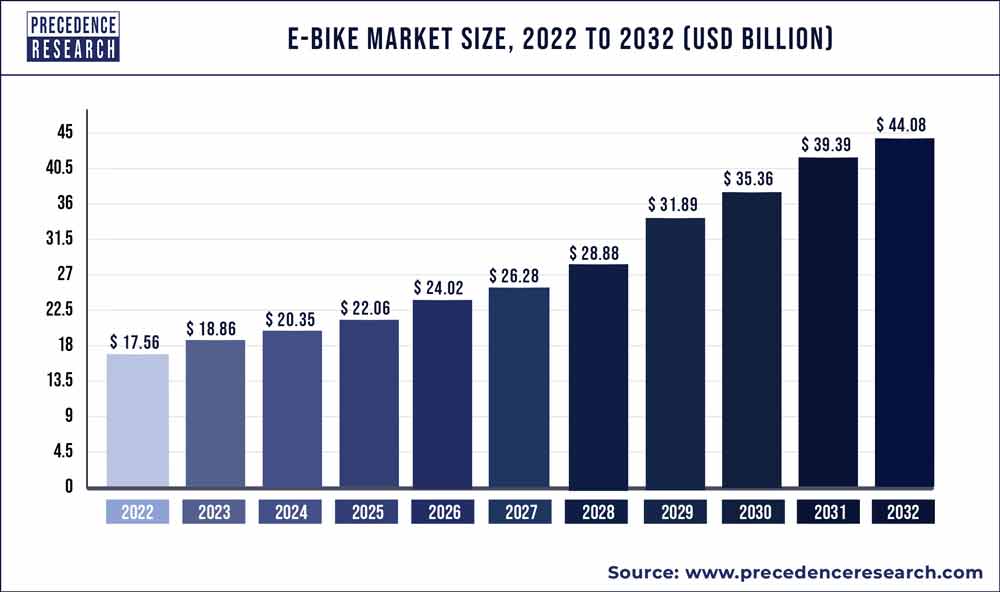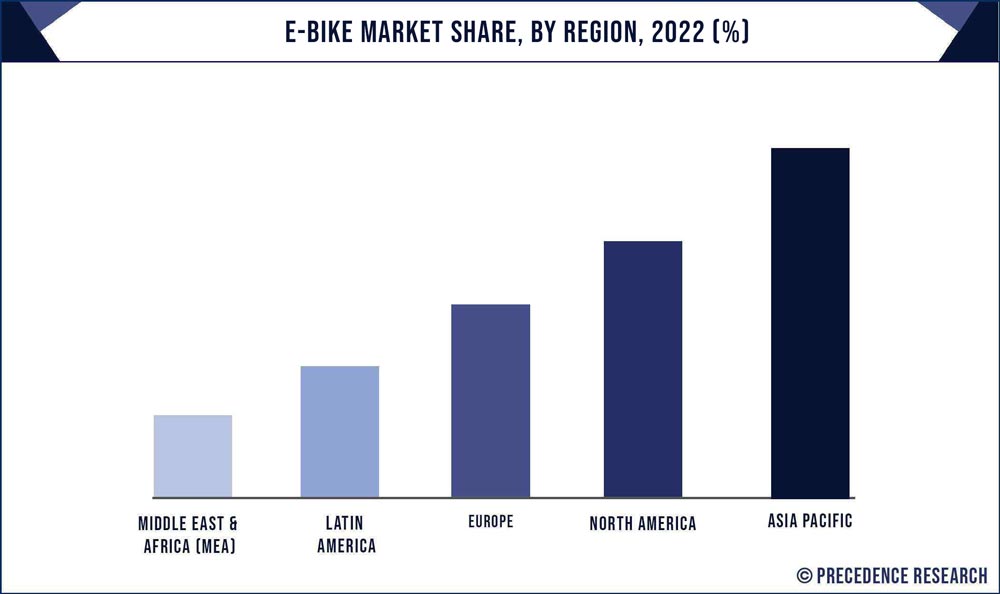
Wheeling Through the Research: Electric Bikes!
Share
We are very excited to start my research for the blogging we will be doing; however, for this particular blog, I am copy and pasted from: Amazing website to start our blog.
This is a rough outline of what we want to cover, not in any particular order but the nuts and bolts of the electric bicycle industry. Please follow, like and comment.
By Class
- Class 1
- Class 2
- Class 3
- Up to 25 km/h
- 25-45 km/h
- Lithium-ion
- Nickel Metal Hydride (NiMH)
- Lead Acid
- Others
- Hub
- Mid-drive
- Others
- Pedal Assist
- Throttle
- Speed Pedelecs
- Scooter or Motorcycle
- Others
The global e-bike market size was valued at USD 17.56 billion in 2022 and is expected to reach over USD 44.08 billion by 2032, poised to grow at a compound annual growth rate (CAGR) of 9.89% from 2023 and 2032.
Electric bikes offer huge growth potential as they endure to gain traction in Europe as a more ecological means of transport. Sales in the U.S. is predicted to lift as associated regulations will take shape. Along with healthy European and U.S. markets and expected rebound in sales in China is projected to offer a more stable environment for the e-bike market place during years to come.

Electric bicycles (e-bikes) are similar to human-powered bicycles with small electric motor that assist or substitute the pedalling efforts. Some models of e-bike offer throttle based motor activation and some offer pedal-assist bike. Complex model with advanced electric motor and optional throttle activation are also available in the market. There are three classes of e-bike available in the market that include Class 1, Class 2, and Class 3. They are generally categorized under two speed ranges that are up to 25 kmph and second is 25-45 kmph.
Main parts of an e-bike include battery pack, electric motor, controller, throttle, PAS & torque sensor, e-brakes, display, torque arms, and hall sensors. Battery pack and electric motor used in an e-bike constitute for majority of e-bike prices. Some of the advantages associated with the application of e-bike are low operating cost, a combined advantage for both bicycle and motorbike, ecological means of transport, good for exercise.
Key Takeaway:
- Asia Pacific e-bike market size was valued at USD 26 billion in 2022.
- By motor type, the hub motor segment accounted for 72% of revenue share in 2021.
- The Li-Ion battery type segment is growing at a CAGR of 4% during the forecast period.
- The throttle segment is expected to grow at a CAGR of 16% over the forecast period.
E-bike Market Share, By Battery Type, 2020 (%)
| Battery Type Segment | 2020 (%) |
| Lithium-ion | 30.83% |
| Nickel Metal Hydride (NiMH) | 20.02% |
| Lead Acid | 46.41% |
| Others | 2.75% |
Some of the major trends and growth factors that govern the market growth of e-bike are discussed below:
- Growing popularity of e-MTB: With the increase in global demand for cycling across the world during past 2 years, one area that has witnessed significant surge in popularity is mountain biking. As per an analysis, mountain biking and trekking market expected to grow at an accelerating rate of 10% during the upcoming years ranging from 2020-2027. Stupendous rise in adventurous sports and tourism likely to propel the market growth for e-MTB.
- Growing preference for bicycles as an eco-friendly vehicle: With increasing necessity of environment-friendly transportation, popularity of bicycles is booming across various parts of the world. This is mainly because of numerous benefits offered by the cycling such as reduced CO2 emission, reduced air pollution, reduced noise pollution from other transportation modes, saves fuel cost, improves public health, less congestion on roads, and also saves construction and maintenance cost of road infrastructure.
- Increasing Popularity of Mid-drive Motors: Hub motors are lighter in weight, simple in construction, and inexpensive to the manufacturers because of which it is the most commonly found motors in the e-bike. However, significant number of advantages offered by the mid-drive motors over hub motors expected to drive their demand overt the forthcoming years. Mid-drive motors offer higher torque and performance compared to traditional hub motors as it drives the crank despite of wheel; hence, multiply its power and allow to take more benefits from the gear system. In respect to maintenance too, mid-drive motors are easier to be service and maintained compared to hub motors. They can be simple removed from the e-bike by replacing nut bolts. Further, they are placed at the center of gravity of the e-bike that helps in better handling of the e-bike by better distribution of the bike weight. Thus, the aforementioned benefits of the mid-drive motor make them more popular compared to hub motors among e-bike manufacturers and the consumers.
Segment Review:
By Class
Class 1 e-bike capture the largest market revenue share of nearly 45% in the year 2022 and expected to maintain its dominance during the forthcoming years as well. The rising demand for pedelecs because of their health assistance along with power assistance within the range of 25 kph that does not have any regulation on its driving likely to propel the growth for class 1 e-bikes.
In Class 2 e-bikes Segment includes both pedal-assist functionality and a throttle that enables motor activation without pedaling, are known for its ease of use. They are particularly appealing to riders who may have physical limitations or prefer a more effortless riding experience. Class 2 e-bikes are commonly used for commuting and leisure riding, offering convenience and flexibility. The availability and demand for Class 2 e-bikes might depend on regional regulations, as some areas may have restrictions on throttle-operated e-bikes. However, in regions where throttle-assist e-bikes are allowed, they can be a popular choice for riders seeking a simple and accessible mode of transportation.
Class 3 e-bikes are estimated to dominate in coming years, The Class 3 E-bikes often referred to as speed peddles, provide pedal-assist functionality with a higher maximum speed of 28 mph (45 km/h). These e-bikes cater to riders who desire a faster alternative to traditional bicycles, making them suitable for commuting longer distances or navigating through urban areas more swiftly. Class 3 e-bikes are commonly used for commuting purposes, as they offer the ability to reach destinations quicker while still benefiting from the assistance of the electric motor. However, the dominance of Class 3 e-bikes can be influenced by local regulations, as some regions may have restrictions or licensing requirements for higher-speed e-bikes.
By Motor Type
Hub motor dominated the global e-bike market with the highest revenue share of nearly 72% in the year 2022 and is expected to maintain the same trend over the forecast time frame as well. The main factor driving their demand is less or minimum maintenance required as they do not exert pressure on the drivetrain and operate independently. On the other hand, mid-drive motor estimated to grow at the fastest rate over the analysis period. This is mainly because they are directly connected to the gears and cranks of the bike and thus offers higher torque and performance compared to hub motors.
By Speed
E-bikes with a speed limit of up to 25 km/h are often classified as low-speed electric bicycles and are commonly used for urban commuting, recreational riding, and short-distance travel. They are popular among a wide range of users, including commuters, students, and casual riders. These e-bikes benefit from relaxed regulations in many jurisdictions, making them more accessible and widely adopted.
On the other hand, e-bikes with a speed range of 25-45 km/h dominate the market with X% of the market share, such as speed peddles or high-speed e-bikes, are subject to more stringent regulations and may require additional licensing, registration, and safety equipment. The market for high-speed e-bikes is typically smaller due to these regulatory restrictions and the specific needs of riders who require faster speeds for longer commutes or traveling on open roads.
By Battery Type
The market has been divided into two types of batteries: lithium-ion (Li-ion) batteries and lead-acid batteries. In 2022, the lead-acid battery sector led the market, accounting for more than 45% of the market. The segment's expansion can be due to the several advantages provided by lead-acid batteries, such as low cost and resilience. However, because these batteries are heavy and drain quickly, their use is expected to dwindle in the coming years.
From 2022 to 2032, the lithium-ion battery segment is expected to increase at a CAGR of 12.9%. According to a European Commission report, the price of lithium-ion batteries is expected to fall by approximately 70% by 2032. High charge density, high performance, lightweight, and high charging-discharging efficiency are expected to favor the adoption of these batteries, consequently aiding segment expansion.
By Application
In 2022, the trekking segment accounted for more than 32% of global revenue. E-bikes are increasingly being used for leisure and hiking purposes. Furthermore, the growing awareness of performance-based adventure, as well as a rising need for leisure activities, are likely to give rise to market growth. Trekking e-bikes and eMTBs are quite adaptable, and some of them are cutting-edge. The greatest are true all-rounders, with intelligent and friendly handling that instills confidence in the city, on bike, woodland, meadow, and gravel pathways, as well as on off-road terrain.
From 2022 to 2032, the cargo segment is expected to increase at remarkable CAGR. The increasing demand for e-bikes to transport luggage from one location to another is likely to help the segment's growth throughout the forecast period. A spike in transportation and freight activity in nations such as India and China is also predicted to fuel e-bike demand.
By Component
Based on components the battery segment dominates the market with highest market share. The battery is a crucial component of an e-bike, providing power to the electric motor. This segment includes various types of e-bike batteries, such as lithium-ion, nickel-metal hydride (NiMH), or lead-acid batteries. Battery capacity, voltage, and charging systems can also be considered within this segment.
On the other hand, the electric motor is responsible for providing propulsion assistance to the rider. This segment encompasses different types of electric motors used in e-bikes, including hub motors, mid-drive motors, and friction-drive motors. Motor power, efficiency, and torque characteristics can also be considered within this segment.
Global E-bike Market Revenue (USD Million) and Growth Rate Comparison by Battery Type (2017-2030)
| Battery Type | 2017 | 2020 | 2030 | CAGR (2021-30) |
| Lithium-ion | 4,036.8 | 5,062.5 | 13,366.9 | 10.20% |
| Nickel Metal Hydride (NiMH) | 2,727.1 | 3,286.7 | 7,618.6 | 8.77% |
| Lead Acid | 6,185.7 | 7,620.4 | 18,927.2 | 9.52% |
| Others | 362.9 | 451.2 | 1,075.7 | 9.08% |
| Total | 13,312.5 | 16,420.8 | 40,988.4 | 9.58% |
Geography Review:
The global e-bike market was valued at USD 15,420 million in the year 2019 and registered a CAGR of 9.6% during the forecast time period.
- Leading Market: The Asia Pacific emerged as the global leader in the e-bike industry owing to prominent growth in the production and demand volume of e-bikes in the region. Approximately 81% of the market revenue in concentrated in the region with China as the front-runner in the region accounting for more than 90% of the global e-bike production concentrated in the country. As per a data published by the China Motor World, total production of e-bike in China accounted more than 30 million in the year 2018. This anticipated to further drives the market growth for e-bike in the region.
- Fastest Growing Market: The Middle East & Africa market in e-bike industry is still at its early adoption phase and reported the fastest growth during the forthcoming years. The prime factor contributing to the significant growth of the region is rapid development in infrastructure for micromobility in the region. Further, in the recent past the region seeks attractive demand for the bike sharing platforms. For instance, in December 2019, PBSC Urban Solutions, a Canada based smart bike-share solution provider announced to enter into a partnership agreement with Careeem, a leading ride-hailing company based in the Middle East, to launch e-bike sharing service in UAE. As per the agreement, the company will provide 3,500 e-bikes and 350 smart stations in the country. Hence, these initiatives in the region expected to bolster the demand for e-bikes in the region.

Market Competition and Players Analysis:
The market players in the global e-bike market faces intense competition among themselves owing to significant investment in order to upgrade the performance of the e-bike and make them more comfortable for the users application. The prime motive behind such investments is to make e-bike as the preferred choice for customers against their passenger cars and other private vehicles. Some of the players have prominently invested in the advancement of the e-bike drive unit in order to enhance its performance.
Key market players profiled under the global e-bike market:
- Accell Group
- Derby Cycle
- Fuji-ta Bicycle Co. Ltd.
- Giant Manufacturing Co. Ltd.
- Jiangsu Xinri E-Vehicle Co. Ltd.
- Mahindra & Mahindra Ltd. (GenZe)
- Prodecotech LLC
- Tianjin Golden Wheel Group Co., Ltd.
- Trek Bicycle Corporation
- Yamaha Motor Co. Ltd.
E-bike company market share, 2022
| Companies | E-bike Revenue (USD Million) | Market share in E-bike Market | E-mountain bike revenue (USD Million) | Market share in e-mountain bike market |
| Trek Bikes | 660.0 | 1.761% | 165.0 | 1.47% |
| Specialized Bicyckes | 240.0 | 0.641% | 72.0 | 0.64% |
| Canyon Bicycles | 479.9 | 1.281% | 144.0 | 1.28% |
| Scott Sports | 34.8 | 0.093% | 10.4 | 0.09% |
| Cube Bikes | 119.6 | 0.319% | 35.9 | 0.32% |
| Bulls Bikes | 3.5 | 0.009% | 1.1 | 0.01% |
COVID-19 Impact Analysis:
The global automotive sector is severely impacted by the outbreak of COVID-19 in early months of the year 2020. In several regions such as North America, Japan, Europe, and other Asian countries, the sale of automotive sector seeks decline of nearly 20%. Further, the mobility service sector was among the severely impacted industries by the coronavirus pandemic. As per a research report published by the University of Chicago, estimates that nearly 40% people have lost their jobs in the U.S. with a steep decline of around 40-50% in the consumer spending. Transit system witnesses almost 90% drop in riders. Uber also reported a decline of 70% in passenger bookings. This collectively has caused heavy loss in revenue to many industries.
